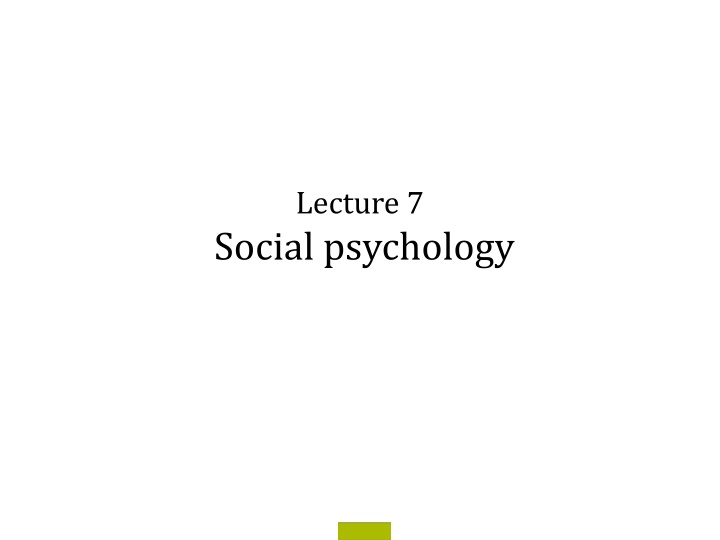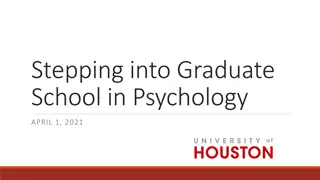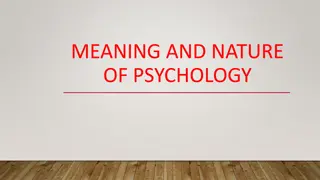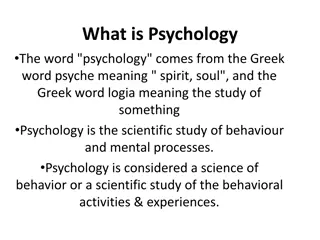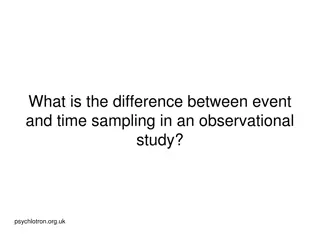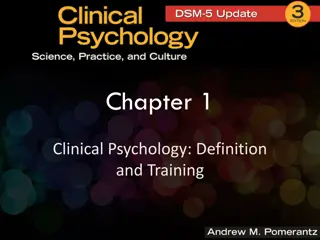Self in Social Psychology
Delve into the concept of the individual and the self in social psychology, exploring how identities have evolved historically and the distinction between collective and individual selves. Learn about self-awareness, Wundt's differentiation of I and me, and Higgins' self-discrepancy theory, shedding light on the interplay between the actual self, ideal self, and ought self.
Download Presentation

Please find below an Image/Link to download the presentation.
The content on the website is provided AS IS for your information and personal use only. It may not be sold, licensed, or shared on other websites without obtaining consent from the author.If you encounter any issues during the download, it is possible that the publisher has removed the file from their server.
You are allowed to download the files provided on this website for personal or commercial use, subject to the condition that they are used lawfully. All files are the property of their respective owners.
The content on the website is provided AS IS for your information and personal use only. It may not be sold, licensed, or shared on other websites without obtaining consent from the author.
E N D
Presentation Transcript
Lecture 7 Social psychology
Social psychology The individual and the self The individual s relations The group The reasons: evolutionary psychology
The individual The self How do we describe and characterise ourselves?
The individual The self The self may be a relatively new idea on the historical timescale. Baumeister imagines that in medieval Europe, identity (and action) were largely determined by one s position in the social order. Visible attributes often directly indicated behaviour. In the 16th century two forces emerged: Secularisation: the idea that fulfillment should be actively pursued in the real world rather than in the afterlife Industrialisation: the ability to move jobs, home, and social status, highlighting a portable personal identity Enlightenment: the idea that existing conventions can be overthrown and replaced, not just lived within Psychoanalysis: viewing the self as an indefinable construct buried in the unconscious
The individual The self Collective vs. individual self: One s own individual traits The properties of the group one belongs to
The individual The self Collective vs. individual self: One s own individual traits The properties of the group one belongs to Social psychology is the study of concepts broader than a single human mind. ...thos emental products which are created by a community of human life and are, therefore, inexplicable in terms merely of individual consciousness since they presuppose the reciprocal action of many. -Wundt Wundt s views influenced Emile Durkheim, founder of sociology.
The individual The self Wundt distinguished between I: the self as the subject, perceiver of the world me: the self as an object, scrutinised by self-judgement or self- awareness
The individual Self-awareness Self-awareness is the direction of attention towards the self as an object. It often involves comparisons with a goal or ideal, allowing it to provoke positive or negative emotions. We have two selves the private self and the public self
The individual Self-awareness Higgins self-discrepancy theory (1987): The actual self The ideal self The ought self A discrepancy between actual self, and idea or ought self, can motivate action to repair the discrepancy. Ideal self: largely prescriptive. Discrepancies cause dejection Ought self: largely proscriptive. Discrepancies cause agitation
The individual How do we describe and characterise the individual?
The individual How do we describe and characterise an individual?
The individual Traits Traits: personal characteristics
The individual Traits Solomon Asch 1907 - 1996
The individual Traits Intelligent Industrious Skilful Determined Practical Cautious Warm/cold Polite/blunt
The individual Traits Intelligent Industrious Skilful Determined Practical Cautious Warm/cold Polite/blunt
The individual Traits Intelligent Industrious Skilful Determined Practical Cautious Warm/cold Polite/blunt Replicated (1950) in a real setting
The individual Traits Asch s configural model: Central traits Peripheral traits 1946
The individual Traits Does it make sense to say that a trait is always central?
The individual Traits Does it make sense to say that a trait is always central? Are there any circumstances under which the centrality of a trait changes?
The individual Traits Primacy effect in impressions: information presented first influences judgement disproportionately
The individual Traits Recency effects also exist, but primacy effects have more pervasive influence. Jones, Edward E., et al. "Primacy and assimilation in the attribution process: The stable entity proposition1." Journal of Personality 40.2 (1972): 250-274.
The individual Traits How do we integrate the effects of different traits?
The individual Traits How do we integrate the effects of different traits? Cognitive algebra (information integration theory) Anderson, N. H. A Simple Model for Information Integration. In R.P. Abelson E. Aronson, W.J. McGuire, T.M. Newcomb, M.J. Rosenberg & P.H. Tannenbaum (Eds.), Theories of Cognitive Consistency: A Sourcebook., Chicago: Rand McNally, 1968 Anderson, Norman H. "Integration theory and attitude change." Psychological Review 78.3 (1971): 171.
The individual Traits Summation (adding) Averaging Weighted averaging
The individual Traits Does the weighted averaging model remind you of anything?
The individual Person memory How do we store traits and recall them? Person memory.
The individual Person memory Access: by person by group by characteristic Dunbar s number: 150 stable social relationships
The individual Attitudes The concept of attitudes is probably the most distinctive and indispensable concept in contemporary American social psychology. No other term appears more frequently in the experimental and theoretical literature. -Gordon Allport, 1935
The individual Attitudes An attitude is: A mental and neural state of readiness, organised through experience, exerting a directive or dynamic influence upon the individual s response to all objects and situations with which it was created. -Gordon Allport, 1935
The individual Attitudes Do attitudes really exist? In other words, should we attribute them as causes of behaviours? Or are they just an epiphenomenon (a mental construct invented to explain behaviours)? They are certainly a major feature of psychological literature.
The individual Attitudes An attitude towards an object can consist of One component: positive or negative affect (Edwards, Thurstone) Three components: thought feeling action (McGuire)
The individual Attitudes are monitored Cognitive consistency Cognitive dissonance Balance theory: Person Object (another person) C (concept) Cartwright, Dorwin, and Frank Harary. "Structural balance: a generalization of Heider's theory." Psychological review 63.5 (1956): 277.
The individual Balance theory
The individual Do attitudes cause behaviours? Attitudes, if they are real phenomena, ought to govern (help to cause) behaviours. In order to detect causation, we need to measure attitudes and behaviour and we need to ensure we are asking the right questions.
The individual Do attitudes cause behaviours? Davidson and Jacard (1979): Attitudes: towards birth control towards using birth control pills towards using birth control pills during the next two years Behaviour: actual use of the contraceptive pill Davidson, Andrew R., and James J. Jaccard. "Variables that moderate the attitude behavior relation: Results of a longitudinal survey." Journal of Personality and Social Psychology 37.8 (1979): 1364.
The individual Do attitudes cause behaviours? Are we measuring specific acts, or general tendencies? The more acts we average over, the greater the predictive power of the attitude (as opposed to other factors affecting single acts).
The individual Do attitudes cause behaviours? Theory of reasoned action (Azjen & Fishbein, 1980) Attitudes influence behaviours according to Subjective norm: exemplar-guided concept of the proper thing to do Attitude towards the behaviour: the individual s beliefs Behavioural intention: internal intention to act Behaviour: the actual performance of the action itself Ajzen, Icek, and Martin Fishbein. "Understanding attitudes and predicting social." Behaviour. Englewood Cliffs, NJ: Prentice-Hall (1980). Find in library. Instead try: Fishbein, Martin, and I. Ajzen. "The influence of attitudes on behavior." The handbook of attitudes (2005): 173-222.
The individuals relationships Attribution Establishing/perceiving/deducing/constructing the causes and explanations for one s own behaviour and that of others
The individuals relationships Attribution Heider: Naive psychology -A search for causes pervades human thought -We try to establish stable traits and abilities in others -We distinguish between internal (dispositional) attribution external (situational) attribution
The individuals relationships Attribution Jones and Davis: Correspondent inference: the attribution of behaviour to an underlying disposition (as opposed to chance) If a behaviour is freely chosen, it is more indicative of an underlying disposition Non-common effects: an effect exclusive to a particular kind of behaviour. Outcome bias is pressure to think that a non-common effect is produced intentionally. Antisocial behaviour generally opposes social norms, so can tell us more about a person s underlying disposition Our inferences are more powerful when someone behaves in a way that affects us (hedonic relevance) Personalistic behaviour (which is intended to help or harm us) strengthens inferences
The individuals relationships Attribution Kelley: Covariation model (1963) People are scientists. They observe which behaviours vary together, and connect them. Using information on: Consistency (whether a behaviour is always performed) Distinctiveness Consensus (the agreement of others)
The individuals relationships Attribution Challenging the covariation model: People may not actually be able to detect covariation Jones, Edward E., et al. "Primacy and assimilation in the attribution process: The stable entity proposition1." Journal of Personality 40.2 (1972): 250-274. Correlation is not causation But here we are defining how causation is constructed from correlation.
The individuals relationships Attribution Subjects received either adrenalin placebo and were informed either symptoms of arousal would result headache and dizziness would result (misinformation) no explanation They then completed paperwork with a confederate (actor) who either behaved euphorically behaved angrily Prediction: the adrenalin-drugged participants who were misinformed would cue their arousal from the confederate s behaviour, inducing them to feel euphoric or angry depending on the confederate. Other groups would feel nothing.
The individuals relationships Attribution Schachter, Stanley, and Jerome Singer. "Cognitive, social, and physiological determinants of emotional state." Psychological review 69.5 (1962): 379. Reattribution can be used as a therapeutic tool
The individuals relationships Attribution Weiner s attributional theory When attributing an achievement, we consider three dimensions: Locus is the achievement internal or external? Stability is this cause stable? Controllability can the actor influence future achievements?
The individuals relationships Attribution The fundamental attribution error or the correspondence bias: The tendency to attribute behaviour to a disposition, even when there are clear external causes. When someone is forced to do something, we have a tendency to see it as a choice. Related to the actor-observer effect: The tendency to make environmental attributions concerning your own actions, but causal attributions concerning those of others.
The individuals relationships Attribution False consensus effect: The idea that everyone will agree with you. A tendency to suppose others judgements will mirror yours. Self-serving biases: Internal attribution, taking credit for your successes External attribution, , denying responsibility for your failures
The individuals relationships Attribution We may not attribute events from environmental information only. Counterfactual thinking is the imagining of past events different from those which really occurred, and deducing their effect on the future. Causation (X causes Y) could be worked out by imagining what the world would look like if X had not happened if, in this case, Y would not have happened either, then X must have caused Y.
The individuals relationships Attribution Attribution can work between groups too. We tend to consider that groups behave like people: memory intentions traits faults and blame The ultimate attribution error: Internal attribution of External attribution of bad outgroupers good outgroupers good ingroupers bad ingroupers
The individuals relationships Affiliation, attraction and love Beauty is in the eye of the beholder? On one hand, social norms (including those of attraction) obviously change. On the other hand, some factors (symmetry, eye size) seem to be universal predictors of attractiveness. Perceived attractiveness also has an undeniable effect on the behaviour of others. Langlois, Judith H., et al. "Maxims or myths of beauty? A meta-analytic and theoretical review." Psychological bulletin 126.3 (2000): 390.
